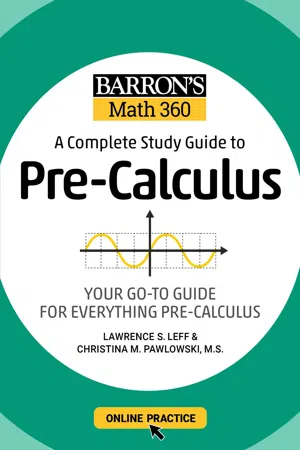Mathematics
Solving and Graphing Quadratic Inequalities
Solving and graphing quadratic inequalities involves finding the values of a variable that satisfy the inequality and representing these solutions on a graph. This process typically includes factoring the quadratic expression, identifying the critical points, and determining the intervals where the inequality is true. The graph of the quadratic inequality is then plotted to visually represent the solution set.
Written by Perlego with AI-assistance
Related key terms
Related key terms
1 of 4
Related key terms
1 of 3
6 Key excerpts on "Solving and Graphing Quadratic Inequalities"
- eBook - ePub
Differentiating Instruction in Algebra 1
Ready-to-Use Activities for All Students (Grades 7-10)
- Kelli Jurek(Author)
- 2021(Publication Date)
- Routledge(Publisher)
Unit Objectives As a result of this unit, students will know:- ➤ quadratic functions have an independent variable raised to a second power,
- ➤ when quadratic functions are graphed they are shaped like parabolas, and
- ➤ all quadratic functions have a vertex, a line or symmetry, and a minimum or maximum.
- ➤ quadratic functions can be written in three different forms, and each form provides key information about the quadratic;
- ➤ quadratic functions can have zero, one, or two solutions;
- ➤ quadratic functions can be solved using various methods; and
- ➤ quadratic functions model real-life situations.
- ➤ identify a quadratic relationship from a graph, table, or equation;
- ➤ find the vertex, axis of symmetry, and roots (zeros) from a graph, table, or equation;
- ➤ solve quadratic equations by graphing, factoring, completing the square, or using the quadratic formula; and
- ➤ interpret maximum and minimum points and intercepts in real-life applications.
Launch Scenarios
- ➤ After a soccer game, teammates shake hands to congratulate each other. How many handshakes are exchanged between a team with seven players? A team of nine players? A team of 11 players? (Lesson 2)
- ➤ You are putting a fence in your backyard to surround your garden, but you are limited to 24 meters of fencing. How should you arrange the fencing in order to maximize the amount of garden space? (Lesson 2)
- ➤ You want to put a decorative stone walking path along two adjacent sides of a water garden. The water garden measures 4 ft by 10 ft. How wide should the path be if there is enough decorative stone to cover 51 square feet? (Lesson 4)
- ➤ You are building a catapult to launch objects in your algebra class. How many feet away from the landing site do you have to place your catapult in order to hit the target? (Lesson 6)
- eBook - ePub
- Stu Schwartz(Author)
- 2013(Publication Date)
- Research & Education Association(Publisher)
x that is in the solution interval.EXAMPLE
Solve |4x − 2| ≤ 14.SOLUTION
(Note that since we divided by a negative number (−4) in the right-hand solution, we reversed the inequality.)(4x − 2) ≤ 14−(4x − 2) ≤ 144x − 2 ≤ 14−4x + 2 ≤ 144x ≤ 16−4x ≤ 12x ≤ 4x ≥ −3The solution is therefore −3 ≤ x ≤ 4, or [−3, 4] in interval notation.Check for x = 0 : |4(0) − 2| ≤ 14 ⇒ 2 ≤ 14, which is correct.EXAMPLE
Solve |2x − 1| > x + 4.SOLUTION(2x − 1) > x + 4−(2x − 1) > x + 42x − 1 > x + 4−2x + 1 > x + 4x > 5−3x > 3x < −1 (Again, we switch the inequality sign here.)So x < −1 or x > 5, or (− ∞, −1) ∪ (5, ∞). Note that the two intervals do not overlap in this example, so the answer has two inequalities for x joined by “or.” We must check each one separately.Check for x = −2 : |2(−2) − 1| > (−2) + 4 ⇒ |−5| > −2 + 4 ⇒ 5 > −2 + 4 ⇒ 5 > 2, which is correct.Check for x = 6 : |2(6) − 1| > 6 + 4 ⇒ |11| > 10 ⇒ 11 > 10, which is also correct.QUADRATIC EQUATIONS AND INEQUALITIES
Quadratic Equations
As we saw in Chapter 4 , second-degree equations are in the form of ax 2 + bx + c = 0 and are called quadratic equations . Quadratic functions can have either two roots, one root, or no roots. Since the roots of the quadratic equation indicate where the quadratic function equals zero, our technique for solving quadratic equations is to set the function equal to zero by moving all the terms to one side of the equal sign, leaving 0 on the other side. Then, to simplify the function, factor it, set each factor equal to zero, and solve for x . Alternatively, the solutions for x - Lawrence S. Leff, Christina Pawlowski-Polanish(Authors)
- 2021(Publication Date)
- Barrons Educational Services(Publisher)
x > 3}FIGURE 4.13 Graph of y = x2 – 2x – 3SOLVING QUADRATIC INEQUALITIES ALGEBRAICALLY
From the graphical solutions of x2 − 2x − 3 < 0 and x2 − 2x − 3 > 0, you know that the roots of the related quadratic equation are the boundary points of the solution intervals. Therefore, you can generalize that, if r and R are unequal roots of ax2 + bx + c = 0, where a is positive and r < R, the values of x that satisfy the related quadratic inequalities are contained in the intervals shown in Figure 4.14 .FIGURE 4.14 Locating the roots of a quadratic inequality on a number lineFor example, to solve x2 − 3x − 10 < 0 algebraically, first solve x2 − 3x − 10 = 0 by factoring the left side of the equation:(x + 2)(x − 5) = 0, so x = −2 or x = 5Then plot −2 and 5 on a number line, as shown in Figure 4.15 . Since the middle interval is the solution of the quadratic inequality in the “less than” case, the solution is −2 < x < 5.FIGURE 4.15 Locating the roots of x2 – 3x – 10 < 0SOLVING A QUADRATIC INEQUALITY WITH A NEGATIVE LEADING COEFFICIENTIf the leading coefficient of the quadratic inequality is negative, rewrite the inequality so that it has a positive leading coefficient. For example, to solve 8x − x2 > 15, first write the inequality in standard form: −x2 + 8x − 15 > 0. Then make the coefficient of the x2 -term positive by changing the sign of each term to its opposite and reversing the direction of the inequality: x2 − 8x + 15 < 0.GENERAL SOLUTION TO A QUADRATIC INEQUALITY
Probably you have already noticed that the solution to a quadratic inequality has a predictable form. Let f(x) = ax2 + bx + c with a ≠ 0. If r and R are the unequal roots of f(x) = 0 with r < R- Stu Schwartz(Author)
- 2013(Publication Date)
- Research & Education Association(Publisher)
15. Solving InequalitiesYou may think that solving inequalities is just a matter of replacing the equal sign with an inequality sign. In reality, they can be more difficult and are fraught with dangers. In calculus, expect to solve a number of inequalities on a regular basis.Solving inequalities is a simple matter if the inequalities are based on linear equations. They are solved exactly like linear equations, remembering that if you multiply or divide both sides by a negative number, the direction of the inequality sign must be reversed.EXAMPLE 21:Solve 2x – 8 ≤ 6x + 2.SOLUTION:If the inequality is more complex than a linear function, it is advised to bring all terms to one side. Pretend for a minute it is an equation and solve. Then create a number line which determines whether the transformed inequality is positive or negative in the intervals created on the number line and choose the correct intervals according to the inequality, paying attention to whether the zeros are included or not.EXAMPLE 22:Solve x2 – 3x > 18.SOLUTION:Solve x2 − 3x − 18 > 0 ⇒ (x + 3)(x − 6) > 0For (x + 3)(x − 6) = 0, x = −3, x = 6So x < −3 or x > 6 or (−∞, −3) ∪ (6, ∞)EXAMPLE 23:SolveSOLUTION:So −1 ≤ x ≤ 5 or [−1, 5]If the inequality contains rational expressions, the method above for solving fractional equations by multiplying both sides of the equation by the LCD will not always work. It can lead to an incorrect solution because of the possibility of multiplying by zero. It is best, then, to bring all terms to one side, and set the numerator and the denominator equal to zero, solve each equation, and then create a sign chart showing intervals where the expression is positive or negative.EXAMPLE 24:Solve .SOLUTION:2x − 4 = 0 ⇒ x = 2x + 5 = 0 ⇒ x = −5So −5 < x ≤ 2 or (−5, 2]Note that multiplying the original equation by (x + 5) would lead to an incorrect solution.16. Exponential Functions and Logs- Caryl Lorandini(Author)
- 2021(Publication Date)
- Barrons Educational Services(Publisher)
10SOLVING INEQUALITIES
WHAT YOU WILL LEARN
•How to write an inequality to represent a constraint or condition in a real-world or mathematical problem •How to recognize that inequalities have infinitely many solutions, and represent solutions of such inequalities on number line diagrams •How to solve inequalities and represent the solution set •How to write inequalities to solve problems by reasoning about the quantities •How to solve word problems leading to inequalities •How to graph the solution set of an inequality and interpret it in the context of the problemSECTIONS IN THIS CHAPTER•What Is an Inequality?•How Do We Represent Solutions of Inequalities?•How Do We Solve Inequalities?•How Can We Use Inequalities to Solve Word Problems?10.1 What Is an Inequality?
DEFINITION
InequalityA mathematical statement containing one of the symbols >, <, ≥, ≤, or ≠ to indicate the relationship between two quantities.An inequality tells you when things are not equal. There are many times when an exact number isn’t needed. Think about situations when you are given a minimum or a maximum. Those situations generate inequalities.EXAMPLE:A curfew of 11 P.M . means be home at or before 11 P.M .You can come home at 9 P.M ., 10 P.M ., or 10:30 P.M .—even 11 P.M .You’d better not come home at 11:30; you would be in trouble. You have to be at least 18 years old to vote. You can be 18, 19, 25, or even 75 (like my Uncle Carl). You can’t be 16, 12, or even 4 (like Charlie). You can be at most 12 years old to order from the kid’s menu. You can be 12, 11, or even just a few months (like Luke). You can’t be 13, 16, or 26 (like Chris). A party room has a maximum capacity of 125 people. You can have 125, 124, or only 6. You can’t have 126, 130, or 250. The fire marshal will shut it down.- Sandra Rush(Author)
- 2013(Publication Date)
- Research & Education Association(Publisher)
a = 0, though, we no longer have a quadratic–according to the definition, there has to be a squared term.Solving a Quadratic Equation
The solutions to a quadratic equation are based on a simple fact: if two factors are multiplied together and the product is 0, then either one or both of the factors must equal 0. There just are no two nonzero numbers whose product is 0. Period. We always write a quadratic equation on one side of the equals sign with 0 on the other so we can see what the factors are.In other words, if we can find two factors for a quadratic equation, its solution is found by setting each of the factors equal to zero and solving for the unknown variable. Each of the factors will contain the unknown to only the first power (x), and we already know how to solve that kind of equation. Then we end up with two roots (solutions) for the quadratic equation.There are many ways to solve a quadratic equation by factoring, and they mostly depend on recognizing what kind of equation is presented and what would be easiest.1. Difference of two squares. If we can recognize the quadratic equation as the difference of two squares (a perfect square, a minus sign, and another perfect square, with no x term, such as x2 – 25), the factors are the sum and difference of the square roots, here (x – 5)(x + 5). Setting each factor equal to 0 we get, x = + 5 or –5, written as x = ± 5 because ±means plus or minus.Another example of the difference of two squares is the quadratic equation x2 – 9 =0. Te factors are (x + 3) and (x – 3). If we set each factor equal to 0, the two solutions to x2 – 9 = 0 are x = ±3.Yet another example of the difference of two squares actually is the difference of two quantities to the fourth power, such as x4 – 16 = 0. If we look at this as the difference of two squares, then the factors are the sum and difference of the square roots, (x2 + 4) and (x2 – 4), but the last factor is itself the difference of two squares, so the factors of x4 – 16 are (x2 + 4)(x + 2)(x –2). In this case, we know two of the roots are x = ±2, but x2 + 4 doesn’t have any real roots because there isn’t any number that, when squared, will yield – 4. Such roots are called imaginary
Index pages curate the most relevant extracts from our library of academic textbooks. They’ve been created using an in-house natural language model (NLM), each adding context and meaning to key research topics.
Explore more topic indexes
Explore more topic indexes
1 of 6
Explore more topic indexes
1 of 4





